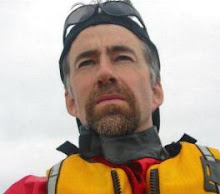A Kayakers' Kampground.

I first discovered Cranberry Campground totally by accident while exploring Merigomish Harbour by sea kayak one windy autumn afternoon. After finding the rare (on this shore) sea stack near the outlet of French River for which I had been searching, I continued along the shoreline out of simple desire to see what else might be at this remote end of a favourite paddling venue.
Almost at the point where Merigomish Harbour narrows to a tiny cove bordered by the beautiful Big Island Beach and the mainland shore, I noticed a group of trailers and tents clustered around a few small buildings and paddled over for a look. There I found a small reedy beach with a soft sandy boat ramp leading into a beautiful meadow in the heart of this jewel of a campground. I went ashore and hardly believing what I was seeing walked the grounds, taking note of the beautiful, large treed campsites, most of which were empty.

The facility was immaculate with water faucets readily available, a shower/laundry hut, bathrooms and even a nice A-frame cottage with communal shelter and cooking facilities for tenters who might want to escape a rainy day. The seasonal campers I approached were friendly to a fault, and the owners were glad to chat with someone who approached from the sea rather than by car.
From my perspective as a sea kayaker though, all this was secondary to the strategic location of this Shangri-la. I’m very familiar with Merigomish Harbour, and have long been an advocate of paddling there. It is one of the very few locations in Atlantic Canada which offers something to all types of paddlers, in a very compact area.
For folks who enjoy paddling quiet estuaries teeming with wildlife, there are several small rivers emptying into the harbour that offer unparalleled opportunity for relaxation.

History buffs will enjoy visiting Smashem Head on Big Island, where a beach stroll could reward you with an arrowhead or other artifact from the huge battle that is believed to have taken place here between the local Mi’ kmaw and the invading Iriquois centuries ago.
The beautiful islands in the harbour offer sandy beaches populated with wheeling eagles and the occasional seal for company as you enjoy a solitary lunch break. Adrenaline junkies will have a great time in the riotous reefy waters of the harbor’s mouth, where incoming tide and outgoing river flow battle it out with contrary winds that slide down off the headland of King’s Head.
For endurance paddlers, a trip leaving Cranberry Campground and circumnavigating the Big Island will fill your day quite nicely with all of the above, with the added reward of finishing up at your campsite for beverages and barbecue. For those wishing to relax, a short paddle from your campsite across the narrows will land you on the gorgeous unsupervised Big Island Beach,
 one of the best-kept secret beaches in the Maritimes. If the surf is running, drag your boat across the road and rip it up! The water is warm, and you can enjoy the view of Pictou Island, Cape George, and Prince Edward Island shimmering on the horizon.
one of the best-kept secret beaches in the Maritimes. If the surf is running, drag your boat across the road and rip it up! The water is warm, and you can enjoy the view of Pictou Island, Cape George, and Prince Edward Island shimmering on the horizon.A short day-trip paddle along the coast will take you to the beautiful shelter of Lismore government wharf, and a bit further on is the dramatic geology of the Arisaig fossil cliff area complete with wispy waterfalls
 and tiny pocket beaches. This area is also steeped in history, and if the surf is not pounding you can land at the Culloden Cairn and pay your respects to the displaced warriors who named this province “New Scotland” in Jacobite Latin.
and tiny pocket beaches. This area is also steeped in history, and if the surf is not pounding you can land at the Culloden Cairn and pay your respects to the displaced warriors who named this province “New Scotland” in Jacobite Latin.If you’re into multi-day trips, consider an expedition from Cranberry around Cape George.
 You will experience amazing geology, desolate sandy beaches,
You will experience amazing geology, desolate sandy beaches,crashing surf, friendly locals and teeming sea life. The beauty of the twin fishing villages of Ballantyne’s Cove and Livingstone Cove is incomparable, and they provide welcome shelter on opposite sides of an imposingly rugged Cape George. If you have exceptionally good legs, you can land on the rocky shelf at the tip of the cape and ascend the tortuous trail to the lighthouse several hundred feet above. And, if you’re really lucky, the seasonal ice-cream stand there will be open.
The ultimate reward for all or any of this activity though, is the comfort and beauty of Cranberry Campground at the end of the day. I’ve seen a few nice sunsets in my time, but Cranberry seems to have some sort of arrangement whereby only the best are served up there each evening. Bring your camera, and lots of memory!







































